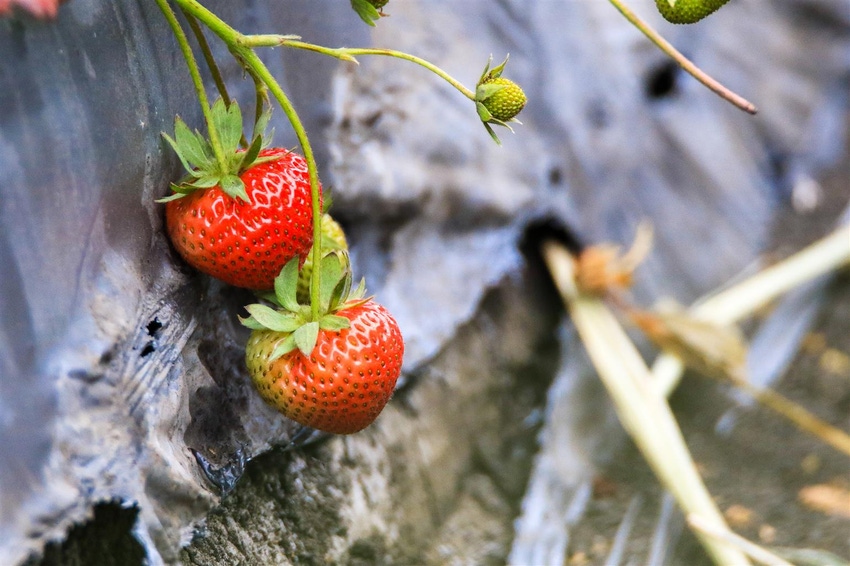May 17, 2017

While California’s Central Coast may have the best growing conditions in the world to produce strawberries, the cost of production can be financially prohibitive, according to a report by the University of California.
The cost study report, written by Central Coast farm advisors Mark Bolda, a strawberry specialist in Santa Cruz County, and Laura Tourte, a specialist in agricultural business and economics in Santa Cruz, Monterey and San Benito counties, reveals the line where strawberry production is profitable and where it’s a losing proposition.
Cost study parameters
The study looks solely at strawberry production in Santa Cruz and Monterey counties and assumes a 50-acre rented farm planted on 48-inch beds with two rows per bed and 12-inch plant spacing for a total of 21,780 plants per acre.
Agronomic practices including common land preparation practices, fumigation and fertilization are assumed in the study as well.
The full study is available online.
According to Bolda, perhaps the biggest “take-home” from this study is in the labor section, where it spells out the costs related to the hand labor needed to harvest the crop.
Strawberries in this study are harvested from April through October with a peak harvest period in June and July. A single 35-person crew plus one supervisor is hired during the slower times with two 35-person crews employed to handle peak production during the early summer. Workers are paid a base rate plus piece-work incentives that Bolda says can easily surpass an equivalent of $20 per hour during the peak season when crop loads are at their heaviest.
For growers in this example to show a net profit, Tourte says they need to be paid more than $10 per tray of eight, one-pound clamshells on a yield that averages at least 7,000 trays per acre. At $9 per tray, production would need to be at least 9,000 trays to surpass the “break-even” point for growers in this scenario.
According to Bolda, the 7,000-tray figure is an industry-average for the region. Figures in the report, along with the entire document, were heavily vetted prior to its release, he said.
Bolda says agricultural wages will play an increasing part in boosting the cost of production as California’s minimum wage rises from $10 per hours to $15 per hour by 2022. During that same period new state legislation will also phase-in overtime rules that reduce the number of hours agricultural workers can work per week before overtime pay kicks in.
Through 2018 the overtime law will allow agricultural workers to work 60 hours in a week before being paid overtime rates. That figure will drop to 40 hours by 2022.
The result will likely be higher labor costs than are shown in the current study and “break-even” prices much higher than are currently shown in the report.
Current conditions
Bolda says growers in the Salinas and Watsonville region started their season receiving prices far below the “break-even” line in the report, though the report says that individual grower costs of production can vary widely.
Nevertheless, growers in his region at the outset of the season, which began in April, were reporting prices of $7 to $8 per tray, a rate which is much more common during peak season periods when more strawberries are being produced.
Bolda attributes the lower grower prices to the overlapping seasons that results in a greater volume of strawberries on the market at the same time.
In California strawberries are produced in three main regions that stretch from Baja California to Watsonville. Those include:
Baja California to Oxnard;
Santa Maria; and,
The Salinas, Watsonville region.
Strawberry production tends to run December through April from Baja California to Oxnard. By mid-February Santa Maria is starting to plant strawberries and in April growers are planting in the Salinas, Watsonville region. Production in the latter two regions will run through September, though Bolda says there are some berries planted in Santa Maria in June that are then harvested in September and October.
Labor availability is also costing growers as fields go unpicked, Bolda says.
So why are growers planting crops they know may not get picked?
Bolda says some growers in that predicament may be in year two of a three-year lease on their land and are simply stuck with not being able to find labor crews to pick their fruit.
“What do you do?” Bolda asks. “You can’t just let the land sit idle and not try to grow something.”
Bolda says mechanization efforts are ongoing, but are simply not moving at a speed necessary to keep up with regulatory and legislative changes that continue to boost the cost of production.
You May Also Like




